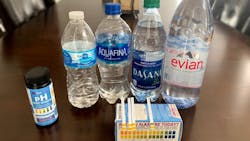Is water harming or helping patients’ teeth?
We all have seen it, those patients who do the right things yet still battle tooth decay. It seems that every time they present for continuing care, they have new caries. It may be recurrent around a crown or composite. It may be root caries or radiographs that reveal new incipiencies. How can this be happening when they do all of the right things? It has come to my attention recently that there might be an answer.
There are countless contributing factors that can raise the risk for decay, such as diet, exposure time, insufficient biofilm control, saliva quality, and xerostomia, to name a few.1–3 We recommend fluorides, remineralizing pastes, saliva substitutes, and products that contain xylitol, as the research indicates these to be effective in controlling caries.4–7 Yet, for some, nothing seems to help. What are we missing? There is clearly another factor involved. When things just don’t add up, we must look elsewhere. So, let’s probe a little further into pH.
pH is a measure of hydrogen ion concentration that determines the acidity or alkalinity of a solution, which ranges from 0 to 14. The lower pH indicates acidity, while a high pH indicates alkalinity. Neutral is a pH of 7. 8
pH is a crucial factor in decay.8 The critical pH is the point at which the tooth begins to decalcify. The critical pH of enamel is 5.2–5.5. The critical pH of dentin is 6.8!9 If you’re like me, you’ve had countless conversations with patients that go something like this: “When you consume anything other than water, your mouth becomes a more acidic environment. Cavity-causing bacteria are more virulent in an acidic environment. It takes approximately 30 minutes for your mouth to recover from an acid attack. The longer you expose your teeth to this acidity …” The key point in this conversation is “anything other than water.”
Several pH testing products are available to the general public and to the dental community to use in their offices. Our office uses a simple, decisively indicative litmus system that collects stimulated saliva for a period of time. The kit tests pH as well as the saliva’s ability to buffer acidity. This has been extremely useful in determining the quality of an individual’s saliva. I’ve been surprised by the number of patients whose sample saliva failed to sufficiently buffer an acidic specimen. This is an ideal situation to prescribe some of the pH-regulating products I mentioned.
More about water
Pure water should be neutral.10 What could possibly be more innocuous than water? It’s the purest substance in everyday life, right? Perhaps not. Recent studies and countless amateur home scientists have proven that water is not always a neutral 7.0. In fact, many bottled waters have been found to be remarkably acidic.11–12
I tested 12 brands of bottled waters, my home tap water, and the water we use in patient care at the office. I was shocked to see the results of my experiment. The majority of bottled waters tested below the critical pH for enamel and dentin demineralization. Even worse, none of the alkaline waters that claim to have a pH of 8.4 or higher reached neutral, much less alkalinity. Surprisingly, our office water and my home water both tested comfortably above 7.0.
Home pH neutralizers use acid neutralizing filters or chemical feed pumps to neutralize pH with calcium carbonate, calcite, or magnesium oxide.13 Water ionizers work via electrolysis to separate the alkaline water from the acidic.14 I was able to make some of the bottled waters I tested more alkaline by adding very small quantities of sodium bicarbonate. This was done for the sake of science; therefore, I caution against recommending this to patients without consulting their physicians, as it would be contraindicated for patients with sodium-restricted diets.
Sodas and coffee are the most universally known acidic beverages. Yet, according to a study published in the Journal of the American Dental Association, 93% of juices, flavored waters, teas, and energy drinks were also determined to have a pH of less than 4.0.10 Carbonated waters add carbon dioxide as a preservative and disinfectant, and it also contributes to the refreshing fizz. Carbon dioxide lowers the pH. Therefore, even flavored and carbonated waters are not as innocuous as they may seem.15
It appears we were ill informed. But I do feel that alkaline water can be the key to reducing caries as long as the pH is reliable. I used to eat fat-free food because I was told fat would make me fat. My father was told to eat liver once a week because it would be good for his heart. Water is good for us, but maybe not all water. Yeah, OK. Change is inevitable, so we must accept it, learn from it, and run with it. Seek more truths and embrace more change.
References
1. van Loveren C, Touger-Decker R. Sugars and dental caries. Amer J Clin Nutrition. 2003;78(4):881S-8925. doi:org/10.1093/ajcn/78.4.881S
2. Cavities/tooth decay. Mayo Clinic. https://www.mayoclinic.org/diseases-conditions/cavities/symptoms-causes/syc-20352892
3. Arshad AI, Ahmad P, Dummer PMH, et al. Citation classics on dental caries: A systematic review. Eur J Dent. 2020;14(1):128-143. doi 10.1055/s-0040-1703419
4. Horst JA, Tanzer, JM, Milgrom PM. Fluorides and other preventive strategies for tooth decay. Dent Clin North Am. 2018 62(2):207-234. doi:10.1016/j.cden.2017.11.003
5. Meyer-Lueckel H, Kielbassa AM, Zahnmed SM. Use of saliva substitutes in patients with xerostomia, 2002;112(10):1037-1058.
6. Aluckal E, Ankola AV. Effectiveness of xylitol and polyol chewing gum on salivary Streptococcus mutans in children: A randomized controlled trial. Indian J Dent Res. 2018;29(4):445-449. doi:10.4103/ijdr.IJDR_307_16
7. Thaweboon S, Thaweboon B, Soo-Ampon S. The effect of xylitol chewing gum on mutans streptococci in saliva and dental plaque, Southeast Asian J Trop Med Public Health. 2004;35(4):1024-1027.
8. Definitions. Britannica. https://www.britannica.com/science/pH
9. Enam F, Mursalat M, Guha U, et al. Dental erosion potential of beverages and bottled drinking water in Bangladesh. Int J Food Properties. 2016;20(11):2499-2510, https://doi.org/10.1080/10942912.2016.1242607
10. Reddy A, Norris DF, Momeni SS, Waldo B, Ruby JD. The pH of beverages in the United States. J Am Dent Assoc. 2016;147(4):255-263. doi:10.1016/j.adaj.2015.10.019
11. Wright KF. Is your drinking water acidic? A comparison of the varied pH of popular bottled waters. J Dent Hyg. 2015;89(2):6-12.
12. Fisher BJ, Spencer A, Haywood V, Konchady G. Relieving dry mouth: Varying levels of pH found in bottled water. Compend Contin Educ Dent. 2017;38(7):e17-e20.
13. Drinking water treatment—pH adjustment. August 23, 2019. Drinking Water Extension. https://drinking-water.extension.org/drinking-water-treatment-ph-adjustment/#How_soda_ash.2Fsodium_hydroxide_injection_works
14. Water ionizers: Electrolyzers. Molecular Hydrogen Institute. http://www.molecularhydrogeninstitute.com/water-ionizers-electrolyzers
15. Ryu HK, Kim YD, Heo SS, Kim SC. Effect of carbonated water manufactured by a soda carbonator on etched or sealed enamel. Korean J Orthod. 2018;48(1):48-56. doi:10.4041/kjod.2018.48.1.48
About the Author

Deanna Schuttler, RDH
DEANNA SCHUTTLER, RDH, lives in Illinois and graduated with an associate degree in applied science from William Rainey Harper College. She has 24 years of experience in private practice.



